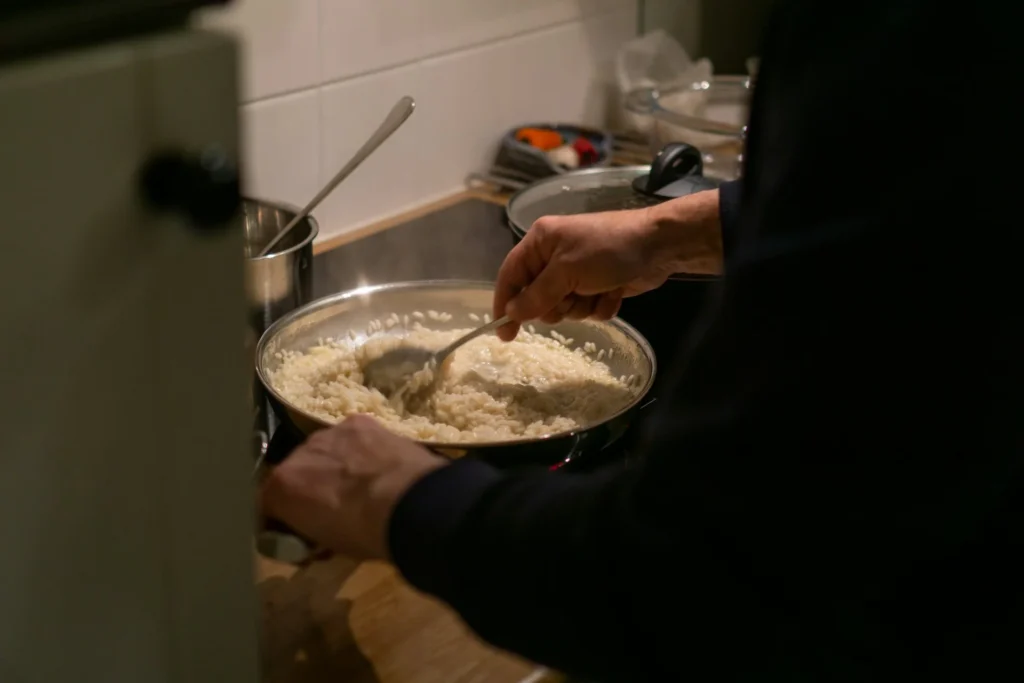Can You Freeze Risotto? Yes…But Here is How
As someone who loves cooking classic Italian dishes, risotto has always held a special place in my repertoire. There’s something so satisfying about watching the Arborio or Carnaroli rice gradually absorb the warm broth or wine as you constantly stir the pot. I still remember the first time I made risotto – I was nervous about getting the consistency just right, but was thrilled with the end result as each bite had a creamy, comforting texture.
Over the years, I’ve experimented with different ingredients to enhance my risottos. One classic combination I find myself making often is asparagus risotto. In the spring when asparagus is in season locally, I’ll gradually add broth mixed with the tender spears to the pot. The bright green color and grassy flavor infused throughout each bite of rice. No matter the additions, the base of the dish always starts with those lovely short grain varieties.
Having a couple young kids now, I’m always looking for quick and easy weeknight meals. That’s why, I now regularly freeze portions of risotto for those busy nights. It works so well to simply portion individual servings onto a baking sheet, then slide them into the freezer once fully chilled. A couple months later when time is tight, I don’t hesitate to dig into the freezer and pull out a bag for reheating. While the texture may not be identical, the flavor is still there – a comforting reminder of those fresh risottos from the beginning of the season. If you want to get a jumpstart on easy home cooking, don’t be afraid to give freezing risotto a try.


The first time I tried freezing and reheating my homemade risotto, I was pleasantly surprised by the results. While the texture was not exactly the same as fresh, it was still rich in flavor and provided a satisfying creamy texture. It seems risotto stands up well to the freezing and reheating process while maintaining much of what makes it such a beloved staple of Italian cuisine. I think part of why risotto works is the classic cooking technique used to prepare it.
As the rice gradually absorbs boiling liquid while being constantly stirred, it releases starch to create its signature creamy consistency. This allows the grains to be well coated with flavor throughout. Even after freezing, reheating seems to gently meld all those flavors back together rather than resulting in a separated or glummy mess.
Contents
- Can You Freeze Risotto
- Freezing Risotto: Yes, It Still Tastes Great, But!
- Can You Freeze Risotto for Babies?
- How To Freeze Risotto
- Alternatives To Freezing
- How Long Can You Freeze Risotto?
- Will Freezing Change The Texture Of Risotto?
- How to Defrost Frozen Risotto
- Can You Refreeze Risotto?
- Reheating Frozen Risotto in the Microwave
- How To Reheat Risotto on the Hob
- Recipes To Make With Leftover Risotto
- Frequently Asked Questions
- Can you vacuum seal risotto?
- How long can risotto last in fridge?
- How do you store homemade risotto?
- How do you reheat risotto to make it creamy?
- Can you freeze butternut risotto?
- Is it safe to reheat frozen risotto?
- How long can you keep risotto in the fridge?
- Can you freeze risotto for arancini?
- Can you eat risotto cold?
- Can I freeze risotto with seafood or delicate ingredients?
Can You Freeze Risotto
So in short – yes, you certainly can freeze risotto for later use! The short answer is that while the texture may not be identical, risotto holds up surprisingly well to the freezing and freezing process.
Freezing Risotto: Yes, It Still Tastes Great, But!
“Freezing risotto is a lifesaver in busy kitchens. Sure, the texture won’t be exactly like a freshly-made dish, but with a bit of broth and gentle reheating, it’s still delicious and satisfying.”
A few things to keep in mind – portion the risotto out before freezing so you only thaw and reheat what you need. Allow time to fully cool the portions first before sealing in an airtight container and placing in the freezer. You can even make large batches in advance and freeze individual servings to pull out ahead for quick meals.
Not only does this help reduce food waste by saving leftover risotto, but it means you can enjoy your homemade risotto again later with only minor reheating effort required. So don’t hesitate to freeze, it’s a great way to enjoy your culinary creations once more with only a little forethought.
Can You Freeze Risotto for Babies?
Answer is YES.
Freezing homemade risotto can be a convenient way to prepare baby food in batches. While rice is a good first food, there are some tips to keep in mind when freezing risotto specifically for babies. The creaminess may separate more upon thawing, so pureeing it extra smooth or mixing in a bit of breastmilk or formula can help maintain a good consistency. It’s best to leave out extras like salty cheeses or herbs initially. Simply cooked rice with a small amount of boiled vegetables pureed in provides optimal nutrition. Allowing individual portions to thaw slowly in the refrigerator ensures safe temperature control. And as with adult servings, clearly dating and labelling the containers will help ensure freshness. With the right handling, freezing homemade risotto is a great option for introducing variety to a baby’s growing palette.
How To Freeze Risotto
When freezing risotto, it’s best to use fully cooked risotto rather than trying to freeze uncooked rice. To freeze, allow hot portions of cooked risotto to fully cool at room temperature. Then transfer to an airtight container, pressing out any excess moisture, and place in the freezer. Label with the date and contents. Frozen in this way, the risotto should maintain quality for 2-3 months. When ready to reheat, thaw only what you need either overnight in the fridge or for a few minutes in the microwave.
Finally, properly cooking or reheating the risotto before serving helps prevent freezer burn. Following these simple steps means your homemade versions can be enjoyed with ease even months after making them fresh.
1- When You’re Ready to Freeze Risotto
Once fully cooled, place portions of risotto in an airtight container or heavy-duty freezer bag. Be sure to label with the date and type (e.g. mushroom risotto) so it’s easy to identify later.
2- Does Risotto Freeze Well
While freezing can cause foods’ quality and texture to deteriorate over time, risotto holds up well in the freezer. It’s technically safe to eat frozen risotto indefinitely, but for best taste and texture it’s recommended to consume within 2-3 months. Following proper freezing and reheating steps helps ensure the risotto retains as much of its original flavor and texture as possible.
Alternatives To Freezing
While freezing is a great option, there are a couple alternatives to consider for leftover risotto depending on your needs and timeline.
Airtight Container:
Once fully cooled, portion risotto can be transferred to an airtight container and stored in the refrigerator for 2-3 days. This helps prevent moisture loss that could cause the risotto to dry out.
Refrigerate:
For a slightly longer storage time, risotto kept in a sealed container in the refrigerator can safely last up to 2 days. If you aren’t ready to eat within that timeframe, you can always freeze the Risotto later.
How Long Can You Freeze Risotto?
As a general guideline, frozen risotto, stored in the freezer for up to 3 months, may begin to lose its flavor and texture. The dish’s quality depends on factors such as the ingredients used, the method of freezing, and how well it is stored. It’s worth noting that the general guideline for frozen risotto is related to the freezer, months, dish, flavor, texture, quality, ingredients, method, freezing, and storage.


While technically safe beyond this timeframe, most sources recommend consuming frozen risotto within 2-3 months for the best results. Following proper preparation and storage methods helps extend its shelf life longer within the freezer. Individual tolerance for texture and flavor changes may also vary the acceptable frozen storage period. But freezing risotto for up to 3 months still provides a good window to enjoy homemade portions later with minimal quality deterioration.
Will Freezing Change The Texture Of Risotto?
A perfectly cooked risotto is a joyous thing – each grain is tender yet with just a hint of chewiness. Unfortunately, subjecting rice to freezing temperatures will inevitably change the delicate texture. However, this doesn’t mean frozen and reheated risotto can’t still be delicious!
While the texture may not be quite the same as when initially cooked, frozen risotto is still perfectly edible once reheated. The freezing and reheating process does impact the texture slightly by causing some starch molecules to burst. But properly frozen and reheated risotto regains a pleasantly creamy consistency even if not identical to when freshly made.
For those who enjoy making risotto but want the option to freeze and eat later, the advice is not to half-cook the rice before freezing for the best possible results when reheating. Fully cooking it first helps the starch set so reheating doesn’t over-soften the grains too much. With some compromise on texture expected, freezing is still a great way to enjoy homemade risotto in a quick and convenient form.
As someone who appreciates both the luxurious texture and rich flavor of a homemade risotto, I was pleasantly surprised by how well the dish holds up after freezing and reheating. While I agree the texture is subtly altered, it remains pleasantly creamy and perfectly edible. Most importantly, the flavors infused during cooking are still vibrant. Being able to make large batches and freeze individual portions gives me the flexibility to enjoy homemade risotto on even my busiest nights. A few minutes of reheating is a small sacrifice compared to the cooking time required to prepare it fresh each time.
Now, I don’t hesitate to take advantage of freezing as a convenient way to savor good meals from days gone by.
How to Defrost Frozen Risotto
When it comes to defrosting frozen risotto, I’ve found the process is simple as long as it’s done properly. By ensuring the dish retains as much flavor and texture as possible during reheating, all of your hard work making the risotto fresh won’t be wasted.
Based on my successes, I would recommend allowing frozen risotto to slowly thaw overnight in the refrigerator. This gradual thawing method in the fridge helps prevent overcooking later on. Then you can choose to gently reheat it on the stovetop, which only requires a bit of stirring to bring it back up to serving temp within about 10 minutes.
I recommend reading these points for better understanding defrosting Frozen Risotto.
How to Thaw Frozen Risotto
1- For gradual thawing, I recommend removing the frozen risotto from the freezer and storing it in an airtight container or sealed bag. Leave the lid or bag slightly open during defrosting. Place in the refrigerator and allow it to defrost slowly overnight. This helps the thaw occur naturally and evenly, preventing the risotto from becoming watery or losing texture.
2- If short on time, you can use the microwave’s defrost function. Place the frozen risotto in a microwave-safe dish and select the defrost setting, adjusting the time and power as needed for the quantity. Be sure to stir periodically for even defrosting. Once fully defrosted, I advise reheating immediately or transferring it to the refrigerator if not using within an extended period, to reduce the risk of bacterial growth.
3- For the fastest defrosting option, use the microwave’s defrost setting and then transfer the frozen risotto directly to a saucepan. Be sure to select a lower power level for a gradual thaw. Stirring frequently is important to prevent sticking or forming lumps during the brief freeze-reheat process. Adding a splash of water, broth or other moisture while reheating helps keep the risotto from drying out as well. Your defrosted risotto will reheat smoothly and safely for an easy, homemade meal. Just take care not to over-defrost or overheat the dish.
Can You Refreeze Risotto?
While the initial freezing and thawing process doesn’t drastically change the texture and quality , each time rice is subjected to temperature changes it can be further affected. As such, refreezing previously cooked food does increase the risk of potential bacterial growth and foodborne illness, as bacteria becomes more resistant to subsequent freezing and thawing cycles.
Therefore, I don’t recommend refreezing risotto that was already thawed and reheated once. It’s better to only thaw the amount you plan to use in that meal. Any leftovers are safer to store in the refrigerator and aim to consume within 3-4 days. That way you avoid potential spoilage that could occur if attempting to refreeze the partially finished dish.
READ: Can You Freeze Pancake Batter?
Reheating Frozen Risotto in the Microwave
While the stovetop method yields the creamiest results, reheating frozen risotto in the microwave can also work well in a pinch. First, remove the risotto from the freezer and allow it to thaw slightly, either in the refrigerator overnight or at room temperature for 30 minutes, to prevent cold spots. Then add a tablespoon or two of water or broth to each serving portion in a microwave-safe dish. This extra liquid will help restore moisture after freezing.
On 50% power to gently heat the rice without drying it out, microwave in 30 second intervals, stirring between each, until piping hot throughout. The key is short bursts and stirring frequently to prevent overcooking spots. With a little practice, “reheating frozen risotto in the microwave” can deliver an acceptably warm and soft rice dish for busy weeknights.
Tips for Reheating Risotto
Reheating frozen risotto is a straightforward process, but it’s important to do it correctly to ensure that the dish is heated evenly and retains its texture and flavor.
1- How To Reheat Risotto
Once defrosted using the methods from the previous section, I transfer the risotto to a microwave-safe dish. Adding a small amount of water or broth can help restore moisture and prevent the dish from drying out during the reheating process. On the stovetop, I place the risotto in a saucepan over medium heat, stirring frequently to ensure even heating. If it seems too thick, I’ll add a touch more water or broth a little at a time until it reaches the desired consistency.
2- How Do You Defrost Risotto in the Microwave
When reheating frozen risotto in the microwave, I use a dish with a microwave-safe lid or cover with plastic wrap, leaving a small gap for steam to escape. I microwave it in 30-second intervals at a high power, stirring in between to prevent overheating. Be sure to check for even heating and don’t let it get dry or rubbery. Once it’s warmed through, check the internal temperature with a food thermometer – it should be hot enough at 165°F (74°C) for food safety. If it needs further warming, go ahead and continue microwaving until you reach the desired temperature.
By following these simple suggestions based on my experience, I hope you can easily and safely enjoy leftovers of your homemade risotto creations. Don’t hesitate to freeze extra portions for later – just take care in the reheating stage.
How To Reheat Risotto on the Hob
When reheating frozen risotto, I like to place it directly in a saucepan over low heat. Adding a splash of liquid like wine or stock can help keep the dish from looking dry as it comes back up to temperature. I gently stir it occasionally and continually until piping hot all the way through. To ensure it’s safely reheated, I check the internal temperature with a food thermometer – it should reach at least 75 degrees C/165 degrees F before serving to be hot enough.


By taking my time and pausing to stir the risotto on the hob, I’ve found this method does a great job of evenly warming it without causing excessive clumping or drying out. The low, slow reheat helps restore the texture and preserved the fresh flavors. I hope sharing this tried-and-true technique proves useful for my readers who want an easy, fuss-free way to enjoy homemade risotto from the freezer once more. With a little care, you can transform it back into a delicious comfort meal.
Reheating Tip
Restoring Creamy Goodness: While risotto can lose some of its original creaminess when frozen, a little extra care during reheating makes all the difference. To revive the luscious texture, gently stir in a splash or two of warm broth or stock while the risotto heats over low heat. This extra moisture helps the rice grains plump up and regain their velvety consistency.
Recipes To Make With Leftover Risotto
While simply reheated risotto makes for a traditional, comforting meal, there are also some fun new ways to utilize any leftovers. A favorite I enjoy making is Rice Balls or Arancini, which involve shaping the cooled risotto into balls then rolling in breadcrumbs before frying for a crispy exterior. Another recipe is Rice Cakes – just form patties and sauté until golden brown.
I also like adding chilled leftover risotto to salad as a hearty topping. The rice soaks up flavors beautifully. You could also try stuffed mushrooms, peppers or tomatoes. The possibilities are endless! Experimenting with new preparations prevents boredom and ensures no risotto ever goes to waste in my kitchen. I hope providing these recipe ideas sparks creativity for my readers too when utilizing their frozen risotto stock.
Repurposing Leftovers
Risotto’s Second Act: Leftover risotto doesn’t have to be a mere repeat performance. With a little creativity, it can be the star of a whole new dish! Consider these tasty transformations:
- Golden Arancini: Mix your leftover risotto with a touch of Parmesan cheese and an egg yolk for extra richness. Shape into small balls, coat in breadcrumbs, and fry until golden brown. These crispy, savory bites are a fantastic appetizer or snack.
- Risotto Fritters: For a lighter variation, form small patties from your leftover risotto and pan-fry them until golden on both sides. These fritters pair beautifully with a fresh salad or a dollop of creamy pesto.
Important Note: These techniques work best with plain risotto or those with sturdy ingredients like mushrooms or vegetables. Delicate additions like seafood or soft herbs might not fare as well after the freezing and reheating process.
READ: Can You Freeze Brownies?
Conclusion
Freezing risotto is an excellent way to preserve homemade batches for convenient reheating down the road. With proper preparation, storage and reheating techniques, frozen risotto can taste nearly as rich and satisfying as when freshly made.
From packaging and thawing instructions to creative recipe ideas, the tips provided here leverage my experiences to help readers feel confident freezing and enjoying risotto later.
Whether sustaining you on busy nights or avoiding food waste, freezing offers an easy solution for maximizing the benefits of cooking risotto from scratch.
______________________________
Frequently Asked Questions
Can you vacuum seal risotto?
Yes, you can vacuum seal risotto, and it’s a good way to preserve leftovers. The lack of air will help it stay fresh in your refrigerator for up to a week. However, be aware that the texture of the rice might change slightly, becoming a bit softer.
Additional things to consider:
- Cool it completely: Make sure your risotto has cooled to room temperature before vacuum sealing. This will help prevent condensation and potential spoilage.
- Portion sizes: Consider freezing risotto in individual serving-sized portions for convenient thawing and reheating.
- Reheating: Gently reheat risotto on the stovetop with a splash of broth or water to restore some of its original creaminess.
How long can risotto last in fridge?
Properly cooked risotto is best consumed within 2 days if left in the fridge, though it can be safely eaten for up to 5 days stored in the refrigerator. I recommend freezing any leftovers to keep them for longer than 3 months.
How do you store homemade risotto?
To store homemade risotto, I like to transfer it to an airtight container and pop it in the fridge to chill quickly. Rice dishes can spoil more rapidly at room temperature.
How do you reheat risotto to make it creamy?
When reheating risotto, the stovetop method works best to make it creamy again. I gently heat it with a few tablespoons of broth or water in a saucepan, stirring frequently as it simmers.
Can you freeze butternut risotto?
You can freeze butternut risotto, though be aware the rice may become harder and take on a grainier texture when frozen. It’s safer to store any leftovers in the fridge to avoid potential texture changes.
Is it safe to reheat frozen risotto?
Yes, it is perfectly safe to reheat frozen risotto! Following the proper reheating instructions, you’ll be able to enjoy that wonderfully creamy and thick texture in your leftovers served up hot all over again. Freezing makes risotto easy to have on hand for a quick, comforting meal.
How long can you keep risotto in the fridge?
According to my experience, properly cooked risotto can safely be kept in the refrigerator for 2-5 days, though the texture and flavor peak within the first 48 hours. In subsection one where I discuss preparing risotto for freezing, I recommend letting cooked batches cool completely at room temperature before refrigerating or freezing for food safety. This allows the rice to finish its cooking process without risk of bacteria growth. Then chilling it promptly helps prevent spoilage that could occur if left out too long. By following safe refrigeration practices like using airtight storage as outlined in subsection two on storing risotto, homeowners can confidently enjoy homemade risotto in the fridge for a few days while retaining its creaminess.
Can you freeze risotto for arancini?
While risotto can successfully be frozen and later used to make arancini, some texture changes may occur. Freezing cooked rice can cause it to firm up more than if used straight from the refrigerator. However, in my experience freezing risotto before shaping and breading it for frying still results in delicious arancini.
The rice maintains enough moisture and integrity to hold its shape once thawed and coated. By first preparing and freezing the risotto according to the established methods from subsections 5-7, then allowing it to fully thaw in the refrigerator before forming balls or patties, any excess water caused by ice crystals melting back can dissipate. With a little care taken in the handling process, frozen risotto produces arancini on par with using freshly made rice straight from the fridge.
Can you eat risotto cold?
While risotto is often served hot straight from the pan, yes you can definitely enjoy it cold as well. The texture may firm up just a bit as it cools, but the tasty rice still holds its creaminess and flavors nicely at room temperature. In fact, cold risotto makes for an excellent pasta or potato salad ingredient – simply toss hot cooked risotto into the mix to soak up the dressing as it cools.
It can also be served cold on its own as a light meal or side. For picnic lunches, prepping extra risotto the night before and packing it chilled in an airtight container works perfectly. So don’t limit risotto only to hot meals – its versatility means you can most certainly eat cold leftovers for breakfast, dinner or on the run as a handy snack.
Can I freeze risotto with seafood or delicate ingredients?
Yes, you can freeze risotto with seafood or delicate ingredients, but it’s best to proceed with some caution. Here’s why:
Texture Changes: Seafood, like shrimp or scallops, can become slightly tougher after freezing and reheating. Delicate herbs and soft vegetables might also lose some of their vibrancy and fresh texture.
Workarounds:
- Consider Partial Freezing: If your risotto includes seafood, you might prepare and freeze the base risotto without the seafood. Cook the seafood separately and add it to the reheated risotto for the best texture.
- Choose Heartier Ingredients: Opt for more resilient seafood like mussels or clams when planning a risotto meant for freezing. Sturdier vegetables like mushrooms or pre-roasted vegetables also handle freezing and reheating better.
Ultimately, the choice is yours! If minimizing food waste is your top priority, freezing the entire risotto is still an option. Just be aware that the seafood or delicate ingredients might not have the same perfect texture as a freshly made dish.






Thanks! it was a great post for me, covering every aspect.
You are welcome! We are glad you found it useful!